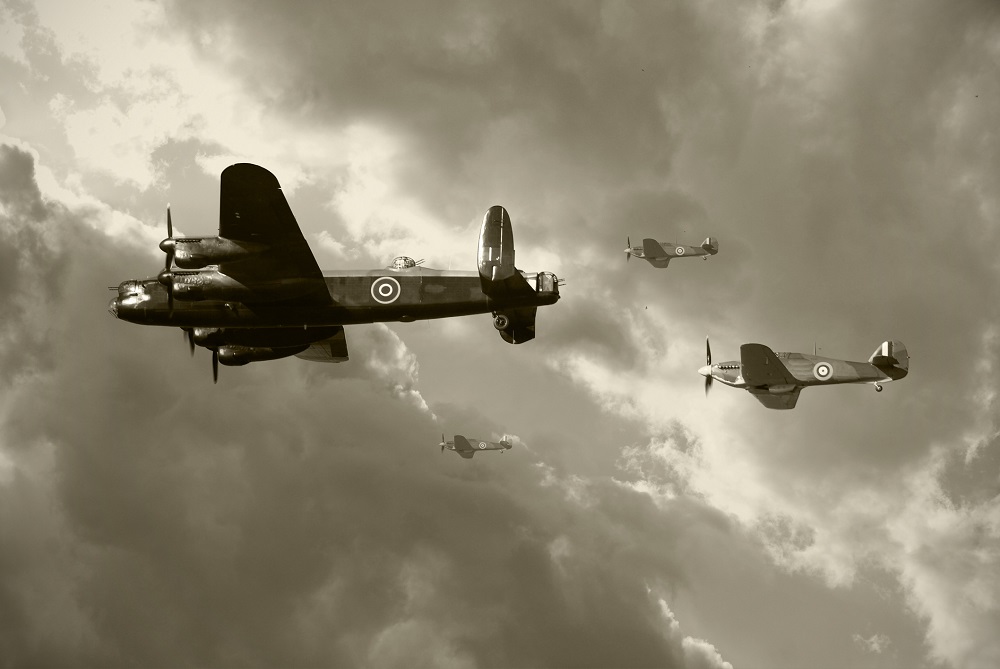This month in history: Operation Chastise
May 2018 marks 75 years since RAF 617 Squadron flew beneath radar coverage and employed the bouncing bomb – a 9,000 pound cylindrical mine, designed to bounce across the surface of the water – to breach the Möhne and Eder dams.
The aim was to flood factory sites and cause  damage to Germany's wartime industrial production, with the late-night mission named
Operation Chastise.
damage to Germany's wartime industrial production, with the late-night mission named
Operation Chastise.
The operation on 16 and 17 May 1943 involved 133 of the best of Bomber Command to fly 19 Lancaster bombers, which took off from RAF Scampton. This included crew from Britain, Canada, Australia, New Zealand and the US.
Only senior members of the squadron were aware of the targets until they were briefed on the day of the raid itself. There had been only two months of intensive low-level training and technical preparation prior to the raid.
After the raid
The Möhne and Eder dams were both breached, with a third, Sorpe, damaged; the ambitious raid had achieved its intention. Though the Germans repaired the dams quickly, the impact of the raid on German industry in the Ruhr valley was significant. The sheer courage, skill, determination and self-sacrifice of the 'Dam Busters' has been remembered long after the event.
The King, prime minister and Air Staff united in congratulating 617 Squadron on their achievement, and an outpouring of national pride followed across the media.
Of the 133 men who took part in the raid, 53 lost their lives and three were captured, becoming prisoners of war.
After the event, Sir Barnes Wallis (knighthood, Gazette issue 44735), inventor of the bouncing bomb, wrote that: “For me the subsequent success [of the raid] was almost completely blotted out by the sense of loss of those wonderful young lives.”
On the ground, almost 1,300 people were killed in the resulting flooding.
A legacy of the raid was an protocol of the Geneva Convention of 12 August 1949, relating to civilian populations (Part IV, Article 15). This protocol forbade the attacking of, among other installations, dams, where such an attack 'may cause the release of dangerous forces and consequent severe losses amongst the civilian population'.
Awards and honours
Tribute is paid in a London Gazette of 25 May, preceding the roll call of honours for personnel:
‘On the night of 16th May, 1943, a force of Lancaster bombers was detailed to attack the Moehne, Eder and Sorpe dams in Germany. The operation was one of great difficulty and hazard, demanding a high degree of skill and courage and close co-operation between the crews of the aircraft engaged. Nevertheless, a telling blow was struck at the enemy by the successful breaching of the Mohne and Eder dams.’ (Gazette issue 36030)
Of the survivors, 34 were decorated at Buckingham Palace on 22 June. For service on that night, the following awards were made: one Victoria Cross, five Distinguished Service Orders, 10 Distinguished Flying Crosses and four bars, two Conspicuous Gallantry Medals, and 11 Distinguished Flying Medals and one bar.
Wing Commander Guy Gibson, who had completed over 170 operations by the age of 26, was awarded the highest award for valour, the Victoria Cross. Here is Gibson’s full citation:
‘This officer served as a night bomber pilot at the beginning of the war and quickly established a reputation as an outstanding operational pilot. In addition to taking the fullest possible share in all normal operations, he made single-handed attacks during his "rest” nights on such highly defended objectives as the German battleship Tirpitz, then completing in Wilhelmshaven.
‘When his tour of operational duty was concluded, he asked for a further operational posting and went to a night-fighter unit instead of being posted for instructional duties. In the course of his second operational tour, he destroyed at least three enemy bombers and contributed much to the raising and development of new night-fighter formations.
‘After a short period in a training unit, he again volunteered for operational duties and returned to night bombers. Both as an operational pilot and as leader of his squadron, he achieved outstandingly successful results and his personal courage knew no bounds. Berlin, Cologne, Danzig, Gdynia, Genoa, Le Creusot, Milan, Nuremberg and Stuttgart were among the targets he attacked by day and by night.
‘On the conclusion of his third operational tour, Wing Commander Gibson pressed strongly to be allowed to remain on operations and he was selected to command a squadron then forming for special tasks. Under his inspiring leadership, this squadron has now executed one of the most devastating attacks of the war—the breaching of the Moehne and Eder dams.
‘The task was fraught with danger and difficulty. Wing Commander Gibson personally made the initial attack on the Moehne dam. Descending to within a few feet of the water and taking the full brunt of the antiaircraft defences, he delivered his attack with great accuracy. Afterwards he circled very low for 30 minutes, drawing the enemy fire on himself in order to leave as free a run as possible to the following aircraft which were attacking the dam in turn.
‘Wing Commander Gibson then led the remainder of his force to the Eder dam where, with complete disregard for his own safety, he repeated his tactics and once more drew on himself the enemy fire so that the attack could be successfully developed. Wing Commander Gibson has completed over 170 sorties, involving more than 600 hours operational flying. Throughout his operational career, prolonged exceptionally at his own request, he has shown leadership, determination and valour of the highest order.’ (Gazette issue 36030)
Find out more
Image: Getty Images
